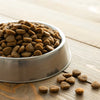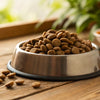Is Cat Dry Food Bad for Dogs? Understanding the Risks and Nutritional Differences
- Houndsy
Table of Contents
- Introduction
- Dog and Cat Dietary Requirements
- Health Risks Associated with Feeding Dogs Cat Food
- What to Do If Your Dog Eats Cat Food
- How to Prevent Your Dog from Eating Cat Food
- Conclusion
Introduction
Have you ever caught your dog sneaking a few bites from the cat's food bowl? If you're a pet parent to both dogs and cats, this scenario might feel all too familiar. In fact, studies suggest that about 70% of dogs will sample cat food at some point, drawn in by its rich aroma and flavor. But the question remains: is cat dry food bad for dogs?
As pet owners, we want to ensure our furry friends receive the best nutrition tailored to their needs. With the growing popularity of various pet foods, it's essential to understand the nutritional differences between cat and dog food, and why a dog's occasional indulgence in cat food might not be as harmless as it seems.
In this blog post, we will explore the underlying reasons why cat food is not ideal for dogs, the potential health risks involved, and practical tips for managing multi-pet households. By the end, you'll have a clearer understanding of how to navigate these feeding dilemmas and maintain your dog's health and well-being.
Dog and Cat Dietary Requirements
Nutritional Needs: Dogs vs. Cats
Understanding why cat dry food can be problematic for dogs starts with recognizing their distinct dietary needs. Dogs are classified as omnivores, meaning they can thrive on a varied diet that includes both animal and plant-based ingredients. In contrast, cats are obligate carnivores, which means their diet must consist primarily of meat. This fundamental difference leads to variations in the nutrient composition of their respective foods.
-
Protein and Fat Content:
- Dogs require approximately 18% protein in their diet, while cats need around 26%. Moreover, cat food typically has higher fat content, often ranging from 9% to 20%, compared to dog food, which averages about 5.5% to 15%.
-
Essential Nutrients:
- Taurine is crucial for cats, aiding in heart and eye health, whereas dogs do not have a specific requirement for this amino acid.
- Arachidonic Acid, a fatty acid necessary for cats, is also absent in dog food, but dogs can synthesize it from other sources.
These differences highlight why a diet intended for cats may not meet the nutritional balance dogs require for optimal health.
Implications of Nutritional Imbalance
When dogs consume cat food, they may ingest an excess of protein and fat, potentially leading to various health issues. While a small amount of cat food might not cause immediate harm, regular consumption can result in long-term complications.
- Gastrointestinal Disturbances: Dogs consuming cat food may experience vomiting and diarrhea due to the higher fat content, which their digestive systems aren't accustomed to processing in large quantities.
- Weight Gain: The calorie density of cat food can contribute to obesity in dogs, especially those prone to weight gain. A dog that relies on cat food may become overweight, leading to further health issues such as diabetes and joint problems.
Health Risks Associated with Feeding Dogs Cat Food
Pancreatitis
One of the most concerning risks is pancreatitis, an inflammation of the pancreas that can be triggered by high-fat diets. Symptoms can include severe abdominal pain, vomiting, lethargy, and loss of appetite. Pancreatitis can be life-threatening and often requires immediate veterinary intervention.
Obesity and Associated Conditions
Long-term ingestion of cat food can lead to obesity, which is a precursor to numerous health issues, including:
- Diabetes: The excess calories from cat food can disrupt a dog's metabolism, raising the risk of developing insulin resistance and diabetes.
- Joint Problems: Overweight dogs may suffer from arthritis and joint pain, limiting their mobility and quality of life.
Nutritional Deficiencies
While cat food is rich in certain nutrients, it lacks the balance needed for a dog's health. Prolonged feeding of cat food may lead to deficiencies in essential vitamins and minerals that dogs require, such as:
- Vitamin A: Necessary for vision and immune function.
- Calcium and Phosphorus: Crucial for bone health.
What to Do If Your Dog Eats Cat Food
Immediate Steps to Take
If you discover that your dog has consumed cat food, there are several steps to follow:
- Monitor Their Behavior: Keep an eye on your dog for any signs of distress, including vomiting, diarrhea, or lethargy.
- Consult with Your Veterinarian: If your dog shows any concerning symptoms or if they have consumed a large quantity, reach out to your veterinarian for advice.
- Prevent Future Incidents: Consider different strategies to keep your dog away from cat food, which we’ll discuss in the next section.
How to Prevent Your Dog from Eating Cat Food
Feeding Strategies
- Separate Feeding Areas: Create dedicated feeding spaces for your cat and dog. Feeding your cat on an elevated surface, such as a cat tree, can keep their food out of reach of curious dogs.
- Scheduled Feeding Times: Instead of free-feeding, establish specific feeding times for your pets. This allows you to supervise mealtime closely and limit access to cat food.
- Interactive Feeders: Use an electronic feeder designed for cats, which only dispenses food when a microchip or tag is detected. This can effectively keep dogs from raiding the cat's food.
Training Techniques
- Positive Reinforcement: Train your dog to leave the cat's food alone using treats and praise. This can help modify their behavior and reinforce boundaries.
- Distraction During Mealtime: Provide your dog with toys or activities during your cat's feeding time to divert their attention away from the cat food.
Conclusion
Navigating the dietary needs of both dogs and cats can be challenging, especially in multi-pet households. While the occasional nibble of cat food may not be immediately harmful, it’s essential to understand the potential risks involved. Feeding your dog a balanced, species-appropriate diet is crucial for their health and happiness.
As pet parents, we have the responsibility to ensure our furry companions receive the right nutrition tailored to their needs. If you're looking for ways to enhance your dog's feeding experience, consider exploring innovative feeding solutions like the Houndsy Kibble Dispenser designed for efficiency and style. This product not only helps manage your dog's feeding routine but also complements your home decor, making it a beautiful addition to your pet care arsenal.
By staying informed about the differences in pet nutrition and taking proactive steps to manage feeding habits, we can ensure our pets lead healthy, happy lives.
FAQ
1. Can a dog die from eating cat food?
While it's unlikely for a dog to die from eating cat food, consuming large amounts can lead to severe health issues, including pancreatitis. Regularly eating cat food is not advisable.
2. What should I do if my dog wants to eat only cat food?
If your dog shows a preference for cat food, consider trying dog food with similar flavors or ingredients that they enjoy, and consult your veterinarian for dietary recommendations.
3. Can I feed cat food to my dog occasionally?
A small amount of cat food occasionally may not cause harm, but it should never replace a balanced dog food diet. Regular consumption can lead to health issues.
4. How can I keep my dog away from cat food?
Implement feeding strategies such as separate feeding areas, scheduled meal times, and training techniques to discourage your dog from eating cat food.
5. What are the symptoms of a dog suffering from pancreatitis?
Symptoms of pancreatitis in dogs can include severe abdominal pain, vomiting, diarrhea, lethargy, and loss of appetite. If you notice these symptoms, contact your veterinarian immediately.












